POLICING THE MULTICULTURAL SOCIETY
Bạn đang xem bản rút gọn của tài liệu. Xem và tải ngay bản đầy đủ của tài liệu tại đây (155.11 KB, 11 trang )
UNIT 8 POLICING THE MULTICULTURAL SOCIETY
1. What do you understand by the notion “multicultural society”?
2. Do you regard your society as being multicultural and can you explain why?
3. Can you describe how at least one ethnic group in your society is culturally
different?
Letting the side down
Read the text and comment on the implications.
Gary Younge, The Guardian, Monday December 17, 2001
At the Majestyk nightclub in Leeds city centre, neon lights cut through dry ice to reveal
huge quantities of bare flesh. In two separate cages, suspended from the ceiling, women
in white bikinis and huge snow boots writhe to the pulsating music then step aside for
young men with torsos shimmering with baby oil to replace them. Down below, with the
help of sweet, fizzy alcohol, the dating game is slowly evolving into the mating game.
Young people with lust in their eyes and a drink in their hand
are coming down with a
ritual attack of Friday night fever. (1)
Outside, the bouncers stand with their backs to the main entrance looking over the city
square. It is the ideal vantage point from which to retrace the flight of Sarfraz Najeib as
he ran from his attackers. But these were no ordinary assailants. Among the accused
were footballers Jonathan Woodgate, who has been found guilty of affray, and Lee
Bowyer, who has been cleared of all charges. Though race was ruled out as a motive (2)
in the retrial of Woodgate, Bowyer and two other men, the case came as a blow (3) to
the club which has spent more than a decade struggling to shake off a reputation as one
of the most racist in Britain.
The Asian student had been beaten to within an inch of his life (4) and the two were
originally charged with racially aggravated assault. The players' fame would ensure
national headlines; the race of their victim initially ensured national debate. The
combination of the two would send both the city and the criminal justice system into
denial.(5) The first trial collapsed in April, when the media also found itself in the dock.
(6) While the jury was still deliberating, the Sunday Mirror published an interview with
Najeib's father insisting that the attack was racist. The judge ruled it the "most serious
form of contempt". (7)
When the trial restarted last month, the jury sat in a quite different world. Nearby
Bradford had been scarred by some of the worst racial unrest since Brixton 20 years
earlier. The events of September 11 added fuel to the fire and once again racial tensions
were running high.
So while media attention this time has not been anywhere near as intense, the
ramifications are still considerable. For in a one-team city which has spent much money
and energy reshaping its image, the repercussions will begin now the trial has ended. In
the past, when club supporters have been involved in violence, the city council has been
quick to distance itself. (8) This time it will not be possible.
Leeds United, despite having, in the 1960s, one of the first black players to play in the
Football League, has always considered itself to be a whites-only club. But the reality of
life in the city ran counter to that. More non-white immigrants settled, particularly in the
Chapeltown area, and the wave of organised racism that spread through the country in
the 1960s and 70s settled on the terraces of Elland Road, where the National Front
recruited openly.
Nick Varley, a Leeds supporter and author of the authoritative Park Life, a Search for
the Heart of Football, recalls hearing at his first match a call-and-response chant
involving "hundreds, possibly thousands of fans", aimed at the one black player on the
pitch.
"Trigger, trigger, trigger," called one side of the stand.
"Shoot that f****** nigger," came the reply.
"Which f****** nigger?"
"That f****** nigger," was the answer, as the crowd pointed at the target of their
venom.
"All around me were fans who joined in," writes Varley. "Not everyone, by any means,
but a lot." By the late 70s, a white Leeds fan, Paul Thomas, had had enough of standing
among what he felt was the silent majority. Along with friends and activists from the
local trades council, he set up Leeds United Against Racism, in order to challenge the
presence of fascists at the ground. "I thought either you tolerated the racism or you did
something about it," he says. When they told police they intended to leaflet (9) the
ground with an anti-racist message, the initial reaction was hostile. The police made it
known through the press that they feared political violence would break out. The club
considered suing the campaigners for unauthorised use of the club badge on the leaflets.
But, says Thomas, the response from fans was encouraging. "Quite a few came up and
congratulated us, saying stuff like: 'It's about time somebody did something about that
lot.”
Under pressure from the council, which then owned the ground, club officials were
persuaded to meet the demonstrators. Despite the choruses of hate ringing from its
stands, the managing director refused to believe there was a problem and demanded
proof. The anti-racists produced Terror on the Terraces, recording the abuse. "It's not as
though we did any great undercover work," says Thomas. "We were just reporting what
had already been reported."
Gradually, thanks to persistent activism, a change of management at the club and more
pressure from the council, the atmosphere started to improve. There were statements
condemning racist chanting from senior management and regular adverts in the
programme against racism. The club developed its links with local black and Asian
communities (it is presently working with Kosovan refugees). It also distributes anti-
racist certificates to schools.
Racism has not been eliminated there, any more than it has anywhere else in the
country, but it is no longer the dominant culture. Recently Thomas sat near a racist
heckler and was backed by other fans when he asked him to stop. When the man
threatened Thomas, he called the club's anti-racist hotline to complain. The club called
him back quickly, asked detailed questions about the incident, and then called again to
say the man's
season ticket had been withdrawn.
Now, once again, Leeds United finds itself associated with allegations of racism,
although this time very much against the run of play. Many Leeds fans - including
committed anti-racists such as Thomas - believe racism was not a factor: "I think it tells
you more about young men and alcohol than it does about race," he says.
Activity 1
Explain the meaning of the underlined words
Discuss with a partner the issue of racial abuse, football ‘culture’ and the roles of the
police and the authorities.
Is this poster effective? Why?
The above poster is part of the Metropolitan Police (London) campaign to stop so-
called “hate crime”. There are other posters in the series which can be seen at their
web-site
www.met.police.uk
Read this text about the approach to multi-ethnic society policing in the
ctivity 2 " Keeping the shop open!"
Some years ago, it might still have been possible to wonder whether the multiethnic
of products he sells to the altered population of
he has always sold, and as a result he will have
ame situation as this greengrocer. But there is one
(Eric van der Horst – Rotterdam – Rijnmond Police Department)
iscussion
ission in “Policing a multicultural society”?
Netherlands.
A
“
society was a reality. Nowadays, we would do better not to fool ourselves with such
basic questions any longer, and to face the facts instead. Allow me to use a metaphor to
illustrate our vision. In major European cities, there are probably still a number of small
local shops, such as the greengrocer on the corner of the street in an old quarter of the
city. There are shops like that in Rotterdam, too. The greengrocer has always sold
traditional Dutch vegetables such as sprouts and cauliflower, which are displayed, fresh
from the auction, in wooden boxes in front of the shop in the morning. But the
population in these districts has changed and many residents of exotic origins prefer
eggplants, olives and rice to traditional goods like cauliflowers and potatoes.
The greengrocer now has two options:
* he may either adjust the range
the neighborhood and stay in business;
* or he can keep on selling what
to close down his shop after a while.
The police are, in fact, in the exact s
major difference: the police can never close down their shop: they will always be in
business”.
D
What do you regard as your police service m
With a partner, speak about the necessary changes, aims and objectives with reference to
this dimension of policing.
Exercise 1 Complete the text using the words in the box below:
enforcement, out, enforced, public, image, force,
warden, uniform, probation, to observe, embodies
aw must be ......(1) if civilized man is to survive. Society cannot depend completely on
marked men.
L
simple persuasion to induce law observance, and therefore it must require enforcement
of law. The term .......(2) implies, as does the very nature of man, the potential use of
........(3) and this potential, then, is necessarily a part of the police role. But the manner
in which this potential is viewed by the public ......(4) often determines whether the
police .....(5) is good or bad. Because good police image tends, to affect favorably an
individual’s willingness ........(6) the law voluntarily, police retain a rightful interest in a
good image. The law enforcement officer .....(7) the law so visibly and directly that
neither the policeman nor the public find it easy to differentiate between the law and its
enforcement. Relatively few citizens recall ever having seen a judge, fewer still, a
prosecutor, coroner, sheriff ........(8) officer or prison .......(9). The patrolman is
thoroughly familiar to all this ......(10) picks him ....(11) from the crowd so distinctly that
he becomes a living symbol of the law. Whether the police like it or not, they are forever
Read the text about a strategy developed by the Dutch police in order to meet the
eeds of a multicultural society.
ld address the issues of multi ethnicity and the
ed into four sub-projects:
1. recruitment and selection
combating discrimination
methods and policies in these four fields.
dio and television
clear that we
lturally biased. As an answer to that problem
BACON
BEARD
AD
Question: What does
n
A few years ago we came to the conclusion that was necessary to develop a police
policy in our service that wou
consequences for our organization. We especially aimed at Turkish and Moroccan
youngsters for several reasons. One of the reasons was that we already had police
officers with another ethnic background coming from our former colonies. We have
chosen an integrated approach.
Therefore this project was divid
2. inflow and career development
3. police training
4. prevention, conflict handling and
It was necessary to develop new
In our regular recruitment campaigns we used national newspapers, ra
guides for our advertisements. We also broadcast commercials. It became
couldn’t reach certain ethnic communities through media. Therefore we had to look for
other ways to get in contact with our target group. We contacted ethnic minority
organisations and asked them for advice.
Another important part of the project concerned selection. We discovered that to a
certain extend our selection process was cu
we tried to develop so-called culturally sensitive tests:
BEER
ULTERY
not belong in this series?
In this example, it is important to realise that you have to approach it from an Islamic
ference in order to be able to answer the question.
colleagues from the “grass-roots”
vel in recruitment and selection. Colleagues were trained to do selection interviews.
at it is necessary to recruit members of minority groups into all aspects
system? Does this happen in Romania and in our police organization?
re
We also learned that it is very important to involve
le
This way they have the idea that they are able to recruit their own future colleagues, and,
by doing this, feel committed to the newcomers from a very early stage. More changes
were needed to offer a friendly environment to these newcomers. A very simple
example is the menu in the police restaurant. This also became more and more
multicultural over the past few years.
Discussion
Do you think th
of the justice









